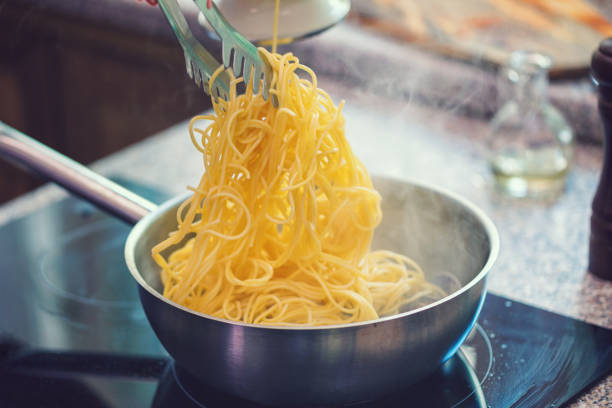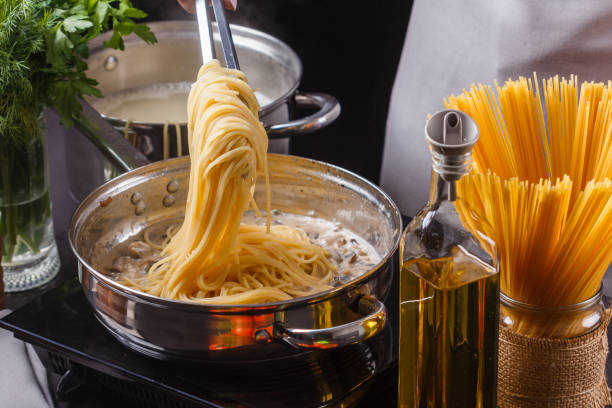Cooking pasta is made easy with our clever tips for cooking pasta and spaghetti. A guide to cooking pasta and important things to watch out for when cooking pasta.
Noodles can be prepared very quickly and in many different ways for a wide variety of meals. Here we have put together the best tips that will guarantee that the noodles will turn out well. Not too soft and not too hard – they should be al dente!
Cooking pasta made easy – in three steps
With just a few simple steps, you can achieve the result of a perfectly cooked pasta. If you follow these instructions, nothing can go wrong even when preparing pasta for the very first time. The three steps make cooking pasta easy.
Step 1: Water and Salt
When cooking noodles, you should always choose a sufficiently large pot in which 1 liter of water is heated for every 100g of noodles (125-150g of dry noodles correspond to approximately one portion at a meal). As soon as the pasta water is boiling, add a teaspoon of salt per liter of water. After a few seconds, the noodles can be added. Be careful not to burn yourself.

With long noodles, such as spaghetti, it usually takes a moment before they are soft enough to be pushed completely into the water. However, it is not necessary to break through these – on the whole, they are easier to eat.
Step 2: Stir and avoid overcooking
Constant stirring to prevent the pasta from sticking or sticking to the bottom of the pot is very important. No oil needs to be added to the cooking water. The pasta water should be constantly simmering with the heat turned down. To prevent the water and foam from boiling over, you can simply leave a wooden spoon in the saucepan. If the water boils over, add some cold water.
Step 3: Drain at the right moment
With the help of a timer that is set to the specified minimum cooking time (see package), you are guaranteed not to miss the moment when you should try the pasta. Incidentally, homemade noodles take much less time than dried noodles. In this case, it is best to stick to the recipe – often just a few minutes are enough to get the right cooking point.
Whether al dente or soft – this is the moment when you have to decide whether the noodles can be carefully drained in a colander – which is ideally already in the sink. There is no need to quench the noodles, which only makes the noodles cold faster, and it also rinses off the starch in the noodles so that the sauce can no longer stick to them. Oil also prevents the sauce from sticking to the pasta. So it’s most recommended to add the noodles straight to the hot sauce, untreated.
Don’t throw away the pasta water, use it in a variety of ways
Pasta water is a true all-rounder. It’s a shame if the water ends up in the sink after draining the pasta. More than ten kilos of pasta were consumed per capita in Germany in 2020, according to the Statista survey portal. The corona pandemic has accelerated the purchase of goods. And the pasta water used can be reused in many areas because the boiled pasta water contains a lot of starch and minerals.
- Mixing sauces and pesto becomes creamier with pasta water. Since the pasta releases starch into the water, the liquid is suitable for thickening sauces. As long as the water is still hot, it should be processed further.
- Adding pasta water to soups and stews. This means that vegetable broth or clear water is often no longer necessary. The starch in the water makes the soup thicker and richer. The water also acts as an aromatic ingredient in other meals.
- Use for pizza and bread dough. Both doughs need water with salt. This is already contained in the pasta water and gives the pastry a special touch. In addition, note a simple guide to making roux yourself.
- Use pasta water to soak beans, lentils, and peas. To do this, soak these products overnight. Then the pasta water creates a special taste.
- Food steaming with the water. So then simply hold the vegetables over the steaming water with a sieve. You can also learn more about healthy steaming of food.
- Water plants with cold pasta water. If you do not want to use pasta water for further cooking, you should let your plants benefit from it. They are happy about the minerals in the water.

Pasta prepared faster
If you need something quick, you can also use fresh pasta from the refrigerated section. You usually only need a few minutes for such noodles to have them ready to serve. Often even heating in the sauce is sufficient.
Alternatively, very thin spaghetti is recommended, which is also cooked in a very short time. These also have the advantage that – in contrast to fresh pasta – they usually do without eggs. This makes them suitable for both egg allergy sufferers and vegans.
Cook pasta differently
TV chef Stefan Marquard shows on YouTube how pasta can be cooked in a somewhat more unconventional way. He promises: that his method does not require any water to be drained off at the end of the cooking process. So don’t mess up the sieve, don’t scald your fingers on the hot steam… Sounds child’s play, give it a try!
